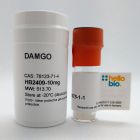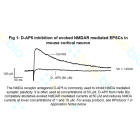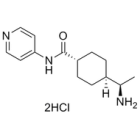Product overview
| Name | Cmpd101 |
| Alternative names | Compound 101; Takeda compound 101 |
| Purity | >98% |
| Customer comments | We would recommend Cmpd 101 from Hello Bio – it performs exactly as expected in assays looking at MOPr desensitisation, phosphorylation and internalisation. Dr Chris Bailey, University of Bath, UK and author on Mol Pharmacol paper, PubMed ID 26013542 Your Cmpd101 – worked great! Dr Steven Gee, Pfizer Neuroscience, USA Your Cmpd101 behaved as expected. Verified customer, Monash University |
| Description | Novel, potent and selective GRK2/GRK3 inhibitor |
Images
Biological Data
| Biological description | Cmpd101 (Compound 101) is a novel, potent and selective G-protein coupled receptor kinase 2 and 3 (GRK2/GRK3) inhibitor (IC50 values are 35 and 32 nM at GRK2 and GRK3 respectively). Shows no activity at GRK5 at concentrations up to 125 µM and shows little activity at a broad range of other kinases. Membrane permeable. Cmpd101 can be used to study roles of GRK2/3 in GPCR desensitization and other functions. Shown to potentiate phosphatidylinositol 4,5-bisphosphate (PIP2) depletion and slow agonist-induced desensitization of protease-activated receptor 2 (PAR2). |
Solubility & Handling
| Solubility overview | Soluble in DMSO (100mM) |
| Storage instructions | -20°C |
| Storage of solutions | Prepare and use solutions on the same day if possible. Store solutions at -20°C for up to one month if storage is required. Equilibrate to RT and ensure the solution is precipitate free before use. |
| Handling | Hydroscopic solid, contact with air may cause material to become sticky. Product performance should not be affected but we recommend storing the material in a sealed jar. |
| Shipping Conditions | Stable for ambient temperature shipping. Follow storage instructions on receipt. |
| Important | This product is for RESEARCH USE ONLY and is not intended for therapeutic or diagnostic use. Not for human or veterinary use. |
Chemical Data
| Purity | >98% |
| Chemical name | 3-[(4-methyl-5-pyridin-4-yl-1,2,4-triazol-3-yl)methylamino]-N-[[2-(trifluoromethyl)phenyl]methyl]benzamide hydrochloride |
| Molecular Weight | 502.92 |
| Chemical structure | ![Cmpd101 [865608-11-3] Cmpd101 [865608-11-3] Chemical Structure](https://cdn.hellobio.com/media/catalog/product//h/b/hb2840.png) |
| Molecular Formula | C24H21N6OF3.HCl |
| CAS Number | 865608-11-3 |
| PubChem identifier | 11677079 |
| SMILES | CN1C(=NN=C1C2=CC=NC=C2)CNC3=CC=CC(=C3)C(=O)NCC4=CC=CC=C4C(F)(F)F |
| Source | Synthetic |
| InChi | InChI=1S/C24H21F3N6O/c1-33-21(31-32-22(33)16-9-11-28-12-10-16)15-29-19-7-4-6-17(13-19)23(34)30-14-18-5-2-3-8-20(18)24(25,26)27/h2-13,29H,14-15H2,1H3,(H,30,34) |
| InChiKey | WFOVEDJTASPCIR-UHFFFAOYSA-N |
| Appearance | Yellow solid |
References for Cmpd101
-
Agonist-selective recruitment of engineered protein probes and of GRK2 by opioid receptors in living cells
Stoeber et al (2019) bioRxiv : https://doi.org/10.1101/866780 -
Contributions of protein kinases and β-arrestin to termination of protease-activated receptor 2 signaling.
Jung et al (2016) J Gen Physiol 147(3) : 255-71 -
Distinct cortical and striatal actions of a β-arrestin-biased D2 receptor ligand reveal unique antipsychotic-like properties.
Urs et al (2016) Proc Natl Acad Sci U S A 113(50) : E8178-E8186 -
Role of G Protein-Coupled Receptor Kinases 2 and 3 in μ-Opioid Receptor Desensitization and Internalization.
Lowe et al (2015) Mol Pharmacol 88(2) : 347-56 -
Molecular mechanism of selectivity among G protein-coupled receptor kinase 2 inhibitors.
Thal et al (2011) Mol Pharmacol 80 : 294-303
-
Endocytic trafficking determines cellular tolerance of presynaptic opioid signaling
von Zastrow et al (2022) Biorxiv : https://doi.org/10.1101/2022.06.15.496340 -
SGIP1 modulates kinetics and interactions of the cannabinoid receptor 1 and G protein-coupled receptor kinase 3 signalosome
Gazdarica M et al (2022) J Neurochem 160(6) : 625-642PubMedID: 34970999 -
GPCR kinases generate an APH1A phosphorylation barcode to regulate amyloid-β generation.
Todd NK et al (2022) Cell reports 40 : 111110PubMedID: 35858570 -
Persistent inflammation promotes endocannabinoid release and presynaptic cannabinoid 1 receptor desensitization
Ingram et al (2022) Biorxiv : https://doi.org/10.1101/2022.06.20.496891 -
A PKA Inhibitor Motif within Smoothened Controls Hedgehog Signal Transduction
Myers et al (2021) bioRxiv https://doi.org/10.1101/2021.07.05.451193 : doi









 Understanding purity and quality - a guide for life scientists
Understanding purity and quality - a guide for life scientists

